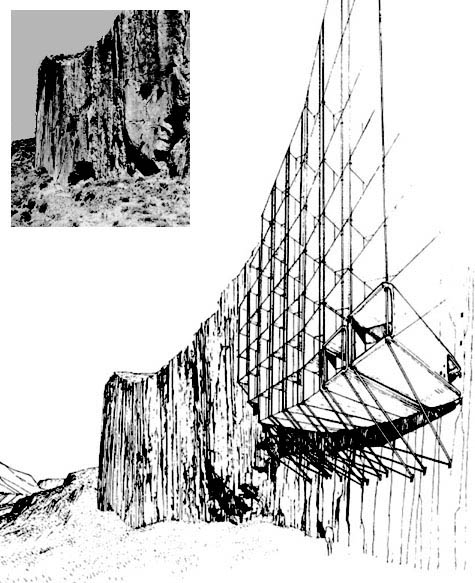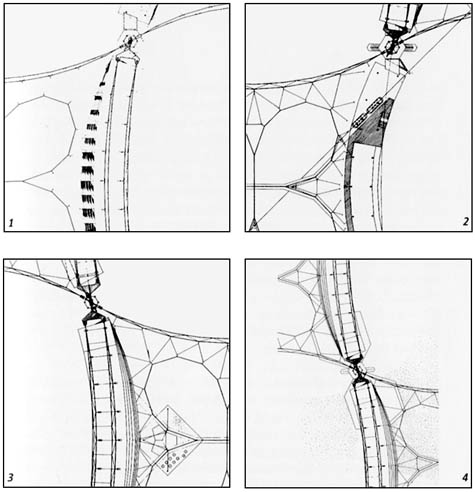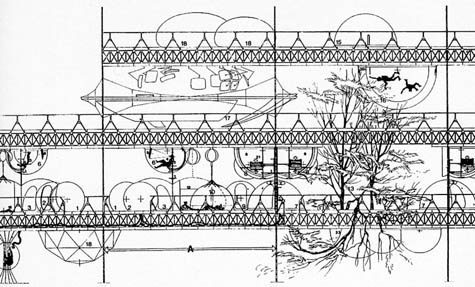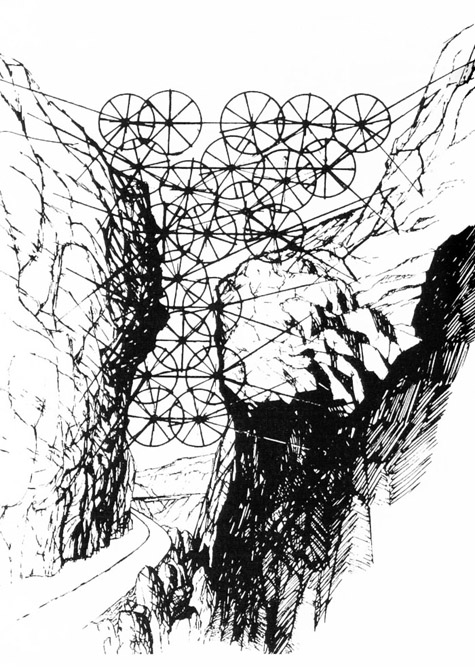Architectural presentations, articles, news, designs, concepts and much more in the world of innovation.
New Blogspot Address
http://modern-arki.blogspot.com, and
http://greenarki.blogspot.com.
My new blogspot would be
http://architectureoverload.blogspot.com.
Sorry for the inconvenience and hoping you visit my new site.
Basque Health Department Headquarters by Coll-Barreu Arquitectos
 photo © Aleix Bagué
photo © Aleix BaguéBasque Health Department Headquarters El Departamento de Sanidad y Osakidetza, the new unified headquarters of the Basque Health Department created by the young and prolific firm Coll-Barreu Arquitectos are located in the Ensanche, New Town (Spain), at the junction of 2 important arteries: Licenciado Poza and Alameda Rekalde, two important streets of the Ensanche, designed in 1862
The restrictive city rules compel to repeat the shape of the neighbouring walls, reducing penthouses according to a curved directive, chamfering the corner and building a tower on it. The building concentrates services and communications in a vertical spine attached to the longest party hedge and generates seven open floors assigned for offices. Above this, there are two floors for local representative and institutional use. The board hall takes up the double height of the tower. The assembly hall, its lobby and its appendages are situated in the first basement. Further below there are two parking floors and one fourth level for archives. The car lifts allow access to all the basement levels.

Aleix Bagué
The double façade solves not only urban requirements but also those concerning energetic, fire-resistant and acoustic insulation from outside. This climatic improvement enables the elimination of the conventional air-conditioning installation as well as the false ceiling.
Thus, the sound produced by the building is reduced, air recirculation in workplaces disappears, with a significant increase of health conditions. The volume occupied per floor is also reduced. The façade responds to the investigation launched by COLL-BARREU ARCHITECTOS in their latest projects, which considers the wrapper as a system. The construction techniques, the operation of the building, the energy exchange, the city and also the very fact, the desire to be ...take part in the system definition, but never the elevation or the composition. The system must provide a valid response to the different situations generated in the façade. Instead of merely set the building on the one hand and shaping the urban space on the other, the façade system should become a social vehicle.
The folded façade generates multiple visual from inside to the streets bellow, and also from the highest floors to the landscape that surrounds the city, a highly effective mechanism for the incorporation of urban vitalism inside the building. The workspace benefits of the permeable, passable and liveable volume of the façade, that enables the building breathing and the space exchange between inside and outside. The system facade of the building is similar to the experience of sitting at the door of a house, above the threshold, with an eye toward the road and the back into the home.
 photo © Aleix Bagué
photo © Aleix Bagué





 photo © Aleix Bagué
photo © Aleix Bagué




Louvre Abu Dhabi exhibition architect announced

Nouvel design to combine with the exhibition architecture of Nathalie Crinière Agence France-Museums, in partnership with Abu Dhabi’s Tourism Development & Investment Company (TDIC), have announced the firm of Nathalie Crinière as exhibition designers for for the Louvre Abu Dhabi, one of the five major institutions being planned for Abu Dhabi Saadiyat Island Cultural District. Nathalie Crinière was awarded the project through a competition among an all French line-up of six invited design firms and will now combine their design with the existing architecture design by Pritzker Prize winning architect Jean Nouvel.
Nouvel’s design concept refers to the existing landscape as arid and explains that this has given way for the design to evolve into fantasy. This can clearly be seen in the renderings which show an expansive web dome ceiling and large water pools complementing the white walls and open spaces.
The 26,000 sq m Nouvel building will join the Sheikh Zayed National Museum, by Lord Norman Foster; the Guggenheim Abu Dhabi Museum, by Frank Gehry; a performing arts center, by Zaha Hadid; and a maritime museum, designed by Tadao Ando to create the Saadiyat Island Cultural District, planned to be the world’s largest single concentration of premier cultural institutions. Louvre Abu Dhabi is currently scheduled for ground breaking later in the year and completion in 2012-2013.
Niki May Young
News Editor






DOROBANTI TOWER

Dorobanti Tower, Render © Zaha Hadid Architects
PROGRAM:
5 Star Hotel & Apartments
CLIENT:
Smartown Investments
SIZE/HEIGHT:
200m
CONCEPT:
IntroductionThe Dorobanti Tower was designed to establish an iconic presence in the heart of Bucharest. The new tower is a unique mix of a distinctive form, ingenious structure, and spatial qualities of sky-high living. The purity of its form - a chamfered diamond like structure - will be a timeless, elegant landmark in the centre of Bucharest. Zaha Hadid Architect’s design concept is a synthesis of architecture and engineering, which integrates a dis-tinct meandering structural mesh frame and naturally expresses the changing programme of hotel, amenities, and residential apartments.The site is located in the centre of Bucharest, to the west of Piaza Romana, and approximately 6km south of the international airport. The brief called for a 100,000 square metre mixed-use development at the junction of Calea Dorobanti and St. Mihail Eminescu. The project comprises 34,000 square metres of a 5-star hotel (including restaurants and a convention centre) and 35,000 square metres of luxury apartments. Additionally, the scheme offers lower level retail areas of 4,600 square metres and it delivers a generous allocation of public realm. This public area will be unlike anything else in Bucharest, representing a major attraction within the dense urban character of the City, offering an important new meeting space and urban plaza.
COMPUTER RENDERS:

Dorobanti Tower, Render © Zaha Hadid Architects

Dorobanti Tower, Render © Zaha Hadid Architects

Dorobanti Tower, Render © Zaha Hadid Architects

Dorobanti Tower, Render © Zaha Hadid Architects
MADRID CIVIL COURTS OF JUSTICE

Birds eye view from West, Render © Zaha Hadid Architects
PROGRAM:
Courts of Law
Campus de la Justicia de Madrid
74,448 sqm: 49,033 overground / 25,415 underground
The formal language and architectural articulation of the design aims to break the static configuration of the surrounding buildings. The design’s soft and dynamic tectonic turns it into an immediate reference for the masterplan, without the need to exhaust maximum building heights.
The Hanging Hotel by Takis Zenetos
The above project – visible in the next image – is for a hanging hotel, a combination of Tibetan palace, Anasazi cliff dwelling, and artificial geological formation.

[Image: The Hanging Hotel, strung onto a cliffside like a musical instrument, by Takis Zenetos].
His most exciting project is Cable City, an incredible 1961 design for a suspended city – what Zenetos called une ville suspendue. The entire metropolis would be hung from cables, a kind of tensional extension of the earth's surface.

[Image: The Cable City of Takis Zenetos].
The overall impetus behind the project seems to be something like counter-terrestriality: a city that would not only span, but even temporarily replace, the earth's surface, forming a cobweb of urban settlement. An extremely local architectural offworld made of capsules, wired Archigramian hammocks, and other high-tech micro-environments.

[Image: The Cable City of Takis Zenetos; the instant city as toupee].




[Images: The Cable City of Takis Zenetos].
He even drew gullies choked with wind turbines – sustainable, if bird-murdering, power stations – decades ahead of his time.

[Images: A turbined gorge by Takis Zenetos].
"Takis Zenetos (1926-1978)," is the pre-eminent architect of Greek modernism, with a varied oeuvre (industrial buildings, schools, residences, objects, urban planning studies), and he is best known for the FIX building on Syngrou Avenue and the Lycabettus theatre.
"What is not widely known is that Zenetos was a visionary of the future electronic city and the digital age."
Ten Notable Architectural Designs
Here's a listing of some of the most notable architectural designs in recent years.
1. Marques de Riscal Hotel, Rioja region, Spain; Architect: Frank O. Geary
2. Planetarium Science Museum and L’Umbracle, Valencia, Spain; Architects: Santiago Calatrava, Felix Candela
3. Valencia Opera House, Valencia, Spain; Architect: Santiago Calavara
4. Selfridges, Birmingham, London; Architect: Future Systems, London
5. Leonardo Glass Cube, Bad Driburg, Germany; Architect: 3 de luxe
6. Kunsthaus Graz, Graz, Germany; Architects: Peter Cook and Colin Fournier;
7. Mikimoto Department Store, Tokio, Japan; Architects: Toyo Ito & Associates & Taisei Design
8. Beijing Olympic Stadium, Beijing, China; Architect: Herzog & de Meuron, Basel
9. Torso Tower, Malmo Harbor, Sweden;Architect: Santiago Calavara
10. Milwaukee Art Museum, Milwaukee, Wisconsin, USA; Architect: Santiago Calavara
and one from the future . The Chicago Spire, Chicago, Illinois, Usa. Architect: Santiago Calavara. To be finalized in 2012. Height: 609,6 metres.



























